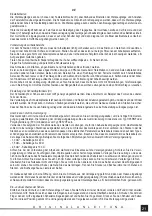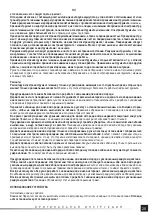
15
O R I G I N A L I N S T R U C T I O N S
EN
is unplugged.
Unexpected activation of the hedge trimmer when removing blocked material or servicing can cause serious injury.
Hold the hedge trimmer only by the insulated handles, as the blade may come into contact with concealed electrical
wires or its own power cord.
Contact of the blades with a live wire can result in exposed metal parts of the hedge trimmer
becoming energised and give the operator an electric shock.
Keep wires and power cords away from the cutting area.
Power cords or cables can be hidden in hedges or bushes and can
be accidentally cut by the blade.
Do not use hedge trimmers in poor weather conditions, especially if there is a risk of lightning.
This avoids the risk of
being struck by lightning.
Safety warnings for extended reach hedge trimmers
To reduce the risk of electrocution, never use extended reach hedge trimmers near electrical lines.
Contact or use near
power lines can cause serious injury or electric shock leading to death.
Always use both hands when operating an extended reach hedge trimmer.
Hold the extended reach hedge trimmer with both
hands to avoid loss of control.
Always wear head protection when operating extended reach overhead hedge trimmers.
Falling debris can cause serious
injury.
PRODUCT OPERATION
Preparing the trimmer for use
Caution! Disconnect the tool from the power supply before performing any assembly and adjustment work.
Disconnect the mains
plug from the mains socket!
Both parts of the trimmer must be assembled before
fi
rst use. Ensure that the blades have been secured by slipping on the guard.
Slide out the inner part of the blade extension and insert it into the blade housing so that the bolt can be passed through the holes
in the blade housing and the hole in the extension, then secure the connection with a bolt and nut (II).
Check the technical condition of the hedge trimmer before connecting it to the power supply. If any damage is detected, it is for-
bidden to connect it to the power supply before rectifying the damage.
Adjustment
Adjustment of the tool length is possible by loosening the locking screw (III), then adjusting the tool length and tightening the
locking screw. The screw must be tightened with such force that the tool does not change length by itself during operation. In
fi
nite
adjustment of the tool length between the movement stops is possible.
Behind the auxiliary handle, there is a clip to attach a carrying strap. The belt clip should be attached to the clamp and hitch (IV)
so that the hitch lock secures the tool against accidental detachment during operation.
The belt should be worn so that it rests on one shoulder and then diagonally wraps around the operator’s chest, allowing the
instrument to be hooked at hip level (V).
Preparing the workplace
Before cutting with the trimmer, properly prepare the workplace to minimise the risks associated with the tool operation. Make sure
that only authorised persons are present at the workplace.
Ensure good visibility from the workplace; that is why take special care when cutting working in di
ffi
cult terrain conditions, e.g.,
on slopes.
It is forbidden to start work during precipitation and in case of high air humidity, e.g., fog.
Wear protective clothing and personal protective equipment.
Avoid cutting wires, young trees, and wooden beams.
Note that cut twigs and plant debris falling may bounce o
ff
other branches or become blocked between other branches. Prepare
an escape route in case of danger from falling branches or plant debris. The escape route should also be free of obstructions while
working. If obstructions appear in the escape path during the work, they must be removed before continuing.
Due to the possibility of working on an overhang, make sure that the trimmer does not come into contact with power lines, tele-
phone lines, etc. Cutting or snagging on such lines can cause electric shock.
Cutting head angle adjustment (VI)
The cutting head of the trimmer can tilt in relation to the handle. This makes it easier, for example, to form the top of the hedge.
Changing the angle of the cutting head is possible by pressing the lock button, holding it down and then changing the angle. The
head can be locked in several positions, marked on the housing. Ensure that the head is locked in its new position and that the
lock button has returned to its rest position.
Power supply connection
The machine is supplied only with a short power cord. Use an extension cord for proper power supply. The extension cord should
Summary of Contents for YT-84790
Page 24: ...24 RU residual current device RCD...
Page 25: ...25 RU...
Page 26: ...26 RU II III IV V VI H05RNF H05VVF 1 0 2 40 1 5 2 60 2 5 2 100...
Page 27: ...27 RU VII VIII 5 10O IX X...
Page 28: ...28 RU 0 2 0 4 XI...
Page 30: ...30 UA residual current device RCD...
Page 31: ...31 UA II...
Page 32: ...32 UA III IV V VI H05RNF H05VVF 1 0 2 40 1 5 2 60 2 5 2 100 VII...
Page 33: ...33 UA VIII 5 10O IX X 0 2 0 4 XI...
Page 85: ...85 GR RCD RCD...
Page 86: ...86 GR o...
Page 87: ...87 GR II III IV V VI H05RNF PVC H05VVF 1 0 mm2 40 m 1 5 mm2 60 m 2 5 mm2 100 m...
Page 88: ...88 GR VII VIII 5 10O IX...
Page 89: ...89 GR 0 2 0 4 mm XI...
Page 91: ...91 BG RCD RCD...
Page 92: ...92 BG II...
Page 93: ...93 BG III IV V VI H05RNF PVC H05VVF 1 0 mm2 40 m 1 5 mm2 60 m 2 5 mm2 100 m VII...
Page 94: ...94 BG VIII 5 10O IX X 0 2 0 4 mm XI...
Page 95: ...95 BG...
Page 107: ...107 AR RCD DCR...
Page 108: ...108 AR II III IV V VI H RNF H VVF PVC VII VIII...
Page 109: ...109 AR IX X XI...
















































